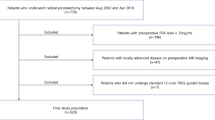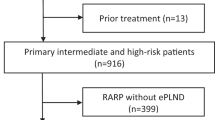Abstract
The objective of this study was to test a novel technique of processing a prostate biopsy (PB) specimen by marking its peripheral end (PE) as a predictive tool for locally advanced prostate cancer (PC) or margin-positive resection (R1) after radical prostatectomy (RP). Prospective evaluation of a consecutive cohort of men who underwent PB and subsequent RP was carried out. Transrectal ultrasound-guided 10–20 core PB was performed according to a standardized protocol. Each biopsy core was inked at the PE and classified as PE positive or negative. The study cohort comprised 100 men with a mean age of 62.3 years (41–75 years). Overall, PE-positive cores were found in 71 men, postoperative tumour (pT)3/pT4 stages were diagnosed in 33 men and R1 status in 45 men after RP. In univariate analysis, the presence of at least one PE-positive core was correlated to an increased risk for pT3/pT4 stage (relative risk (RR): 3.15; 95% confidence interval (95% CI): 1.1–9.9; P=0.03) and R1 status (RR: 2.9; 95% CI: 1.1–7.5; P=0.03). In multivariate analysis including Gleason score, total number of positive cores, PE positivity and PSA, PE positivity was correlated to pT3/pT4 stage (P=0.04). In conclusion, PC at the PE of a PB specimen predicts non-organ-confined tumour stage in subsequent prostatectomy. This simple, new technique may contribute to increasing the accuracy of risk stratification for curative treatment of PC.
This is a preview of subscription content, access via your institution
Access options
Subscribe to this journal
Receive 4 print issues and online access
$259.00 per year
only $64.75 per issue
Buy this article
- Purchase on Springer Link
- Instant access to full article PDF
Prices may be subject to local taxes which are calculated during checkout




Similar content being viewed by others
References
Heidenreich A, Bolla M, Joniau S, Aus G, Matveev VB, Schmid HP et al. EAU guidelines on prostate cancer. EAU 2009; 33: 113–126.
Montironi R, Mazzucchelli R, Scarpelli M, Lopez-Beltran A, Mikuz G, Algaba F et al. Prostate carcinoma II: prognostic factors in prostate needle biopsies. BJU Int 2006; 97: 492–497.
Epstein JI, Allsbrook Jr WC, Amin MB, Egevad LL . The 2005 International Society of Urologic Pathology (ISUP) Consensus Conference on Gleason grading of Prostatic Carcinoma. Am J Surg Pathol 2005; 29: 1228–1242.
Grossklaus DJ, Coffey CS, Shappell SB, Jack GS, Chang SS, Cookson MS . Percent of cancer in the biopsy set predicts pathological findings after prostatectomy. J Urol 2002; 167: 2032–2035.
Freedland SJ, Terris MK, Csathy GL, Kane CJ, Amling CL, Presti Jr JC et al. Preoperative model for predicting prostate specific antigen recurrence after radical prostatectomy using percent of biopsy tissue with cancer, biopsy Gleason grade and serum prostate specific antigen. J Urol 2004; 171 (6 Part 1): 2215–2220.
Sebo TJ, Cheville JC, Riehle DL, Lohse CM, Pankratz VS, Myers RP et al. Predicting prostate carcinoma volume and stage at radical prostatectomy by assessing needle biopsy specimens for percent surface area and cores positive for carcinoma, perineural invasion, Gleason score, DANN ploidy and proliferation, and preoperative serum prostate specific antigen: a report of 454 cases. Cancer 2001; 91: 2196–2204.
Partin AW, Kattan MW, Subong EN, Walsh PC, Wojno KJ, Oesterling JE et al. Combination of PSA, clinical stage and Gleason score to predict pathological stage of localized prostate cancer: A multi-institutional update. JAMA 1997; 277: 1445–1451.
Walsh PC, De Weese TL, Eisenberger MA . Localized prostate cancer. N Engl J Med 2007; 357: 2696–2705.
Kattan MW, Stapleton AM, Wheeler TM, Scardino PT . Evaluation of a nomogram used to predict pathological stage of clinically localized prostate carcinoma. Cancer 1997; 79: 528–537.
Scattoni V, Zlotta A, Montironi E, Schulman C, Rigatti P, Montorsi F . Extended and saturation prostatic biopsy in the diagnosis and characterization of prostate cancer: a critical analysis of the literature. Eur Urol 2007; 52: 1309–1322.
D’Amico AV, Wu Y, Chen MH, Nash M, Renshaw AA, Richie JP . Perineural invasion as a predictor of biochemical outcome following radical prostatectomy for selected men with clinically localized prostate cancer. J Urol 2001; 165: 126–129.
de la Taille A, Katz A, Bagiella E, Olsson CA, O'Toole KM, Rubin MA . Perineural invasion in prostate needle biopsy: an independent predictor for final pathological stage. Urology 1999; 54: 1039–1044.
Descazeaud A, Rubin MA, Allory Y, Burchardt M, Salomon L, Chopin D . What information are urologists extracting from needle biopsy reports and what do they need for clinical management of prostate cancer? Eur Urol 2005; 48: 911–915.
Joseph T, McKenna DA, Westphalen AC, Coakley FV, Zhao S, Lu Y et al. Pretreatment endorectal magnetic imaging and magnetic resonance spectroscopic imaging features of PC as predictors of response to external beam radiotherapy. Int J Radiat Oncol Biol Phys 2009; 73: 665–672.
Guillonneau B, El-fettouh H, Baumert H, Cathelineau X, Doublet JD, Fromont G et al. Laparoscopic radical prostatectomy: oncologic evaluation after 1000 cases at Montsouris Institute. J Urol 2003; 169: 1261–1266.
Stolzenburg JU, Rabenalt R, Do M, Truss MC, Burchardt M, Herrmann TR et al. Endoscopic extraperitoneal radical prostatectomy: the University of leipzig experience of 1300 cases. World J Urol 2007; 25: 45–51.
Han M, Partin AW, Pound CR, Epstein JI, Walsh PC . Long term biochemical disease-free and cancer-specific survival following anatomic radical retropubic prostatectomy. The 15-years Johns Hopkins experience. Urol Clin North Am 2001; 28: 555–565.
Author information
Authors and Affiliations
Corresponding author
Ethics declarations
Competing interests
The authors declare no conflict of interest.
Rights and permissions
About this article
Cite this article
Ponholzer, A., Rauchenwald, M., Rainer-Concin, A. et al. Prostate cancer at the peripheral end of a prostate biopsy specimen as assessed by a novel marking technique may indicate increased risk of locally advanced disease. Prostate Cancer Prostatic Dis 14, 69–73 (2011). https://doi.org/10.1038/pcan.2010.40
Received:
Revised:
Accepted:
Published:
Issue Date:
DOI: https://doi.org/10.1038/pcan.2010.40



